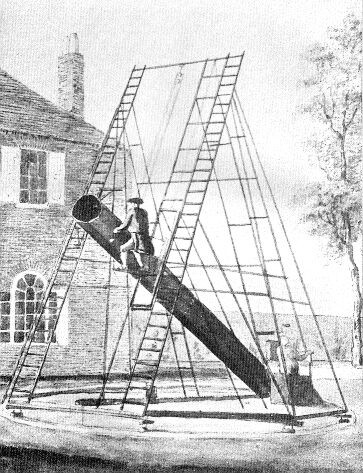
Caption: William Herschel (1738--1822) (one assumes) and his 20-foot telescope (reflector, primary diameter 18.5 inches ≅ 47 cm) at Slough, England near Windsor Castle (see also No-400).
Features:
- As you can see in the image, Herschel
had NO dome.
Everything was so much simpler without a dome.
- Herschel
just stood at the top end of the tube and viewed the
real image created by
the primary mirror with
an eyepiece he held in his hand???---simple, but
it worked
(Wikipedia: Optical telescope:
Principles).
- As you can see, the telescope was supported by
quasi-permanent scaffolding,
pulleys,
and rope.
- The telescope has an
equatorial mount
and can be slewed a fair ways
along the
(celestial) meridian
(i.e., along the
north-south direction).
However, the scaffolding being aligned with celestial meridian only allowed limited east-west slewing.
However, astronomical objects within the north-south range transit the meridian daily, and so can be observed for some short time by the limited east-west slewing.
- The
20-foot telescope
(reflector, primary diameter 18.5 inches ≅ 47 cm)
is, of course, a reflector: i.e.,
its primary is
a mirror, NOT
a lens as for
reflectors.
- Most professional telescopes
up to circa 1900 were
refractors.
Reflectors have advantages which
would cause them to win out as the dominant telescope
after circa 1900
(Wikipedia: Reflecting telescope:
History).
Some of these advantages were appreciated by Herschel: it is easy to make large reflectors (compared to making large refractors) and reflectors do NOT suffer from chromatic aberration instrinsically.
- Early reflectors
were all made of speculum
for the mirror.
Speculum is an alloy of copper and tin with a dash of arsenic---which gives that je ne sais quoi---invented for reflector telescope mirrors by Isaac Newton (1643--1727).
It is brittle, tarnishes easily, and reflects only about 16 % of incident light.
Newton also constructed the first working reflector telescope, Newton's reflector (primary diameter 5 cm ≅ 2 inches, operational 1668--c.1731) based on earlier ideas by Scottish mathematician and astronomer, James Gregory (1638--1675) published in 1663 (North 1994, p. 347).
- The
20-foot telescope
(reflector, primary diameter 18.5 inches ≅ 47 cm)
was probably Herschel's most useful
telescope.
The 40-foot telescope
(reflector, primary diameter 1.22 m ≅ 48 inches, operational 1787--1815)---the record
largest telescope of its time---was simply
difficult to use because of its size given
Herschel's primitive
telescope mounting
The 40-foot telescope was used in the discovery (though maybe in combination with his other telescopes) in 1789 of Enceladus and Mimas, the 6th and 7th moons of Saturn (Wikipedia: 40-foot telescope: Use; (Wikipedia: Discovery: Enceladus; Wikipedia: Mimas: Discovery).
- The
40-foot telescope
(reflector, primary diameter 1.22 m ≅ 48 inches, operational 1787--1815)
was surpassed by the
Leviathan of Parsonstown
(reflector, primary diameter 1.83 m = 6 ft, operational 1845--c.1890)
in 1845.
Credit/Permission: Anonymous artist,
later 18th century /
Public domain.
Download site:
Wolfgang Steinicke's List
of NGC/IC observers